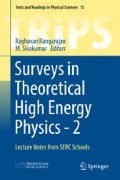Abstract
Quantum Chromodynamics (QCD) is the theory of strong interaction force among hadrons. It is a gauge theory based on a non-Abelian gauge group namely SU(3). In the following, I will describe the perturbative aspects of QCD that is relevant for studying high energy scattering processes involving hadrons.
Access this chapter
Tax calculation will be finalised at checkout
Purchases are for personal use only
Preview
Unable to display preview. Download preview PDF.
References
T. Muta, Foundations of Quantum Chromodynamics, 3rd ed., World Scientific, Singapore (2010).
J. Collins, Foundations of Perturbative QCD, Cambridge University Press, Cambridge, UK (2011).
R. D. Field, Applications of Perturbative QCD, Addison-Wesley Publishing Company, Reading, USA (1989).
J. Collins, Renormalisation, Cambridge University Press, Cambridge, UK (1984).
R. K. Ellis, W. J. Stirling and B. R. Webber, QCD and Collider Physics, Cambridge University Press, Cambridge, UK (2003).
T.-P. Cheng and L.-F. Li, Gauge Theory of Elementary Particle Physics, Oxford University Press, Oxford, UK (2009).
I. J. R. Aitchison and A. J. G. Hey, Gauge Theories in Particle Physics, vol. 2, Taylor Francis Group, UK (2004).
M. E. Peskin and D. V. Schroeder, An Introduction to Quantum Field Theory, Westview Press, Kolkata, India (2005).
G. Sterman, Quantum Field Theory, Cambridge University Press, Cambridge, UK (1994).
S. Weinberg, Phys. Rev. D 8, 605 (1973).
S. Weinberg, Phys. Rev. D 8, 4482 (1973).
D. J. Gross, ‘Gauge theory - past, present and future’, in Chen Ning Yang, edited by C. S. Liu and S. T. Yau (1997), pp. 147-162.
A. H. Mueller, Phys. Rept. 73, 237 (1981).
D. J. Gross and F. Wilczek, Phys. Rev. Lett. 30, 1343 (1973).
D. J. Gross and F. Wilczek, Phys. Rev. D 9, 980 (1974).
G. Altarelli and G. Parisi, Nucl. Phys. B 126, 298 (1977).
D. J. Gross, Phys. Rev. Lett. 32, 1071 (1974).
G. ’t Hooft and M. J. G. Veltman, Nucl. Phys. B 44, 189 (1972).
G. F. Sterman, ‘Partons, factorization and resummation, TASI 95’, in Boulder 1995, QCD and Beyond, pp. 327-406 [arXiv:hep-ph/9606312].
D. E. Soper, ‘Basics of QCD perturbation theory’, in Stanford 1996, The Strong Interaction, From Hadrons to Partons, pp. 15-42 [arXiv:hepph/9702203].
R. Brock et al. [CTEQ Collaboration], Rev. Mod. Phys. 67, 157 (1995).
A. Grozin, arXiv:1205.1815 [hep-ph].
P. Z. Skands, arXiv:1104.2863 [hep-ph].
J. C. Collins, Acta Phys. Polon. B 34, 3103 (2003) [arXiv:hep-ph/0304122].
Author information
Authors and Affiliations
Corresponding author
Editor information
Editors and Affiliations
Rights and permissions
Copyright information
© 2016 Springer Science+Business Media Singapore 2016 and Hindustan Book Agency 2014
About this chapter
Cite this chapter
Ravindran, V. (2016). Perturbative Quantum Chromodynamics. In: Rangarajan, R., Sivakumar, M. (eds) Surveys in Theoretical High Energy Physics - 2. Texts and Readings in Physical Sciences, vol 15. Springer, Singapore. https://doi.org/10.1007/978-981-10-2591-4_3
Download citation
DOI: https://doi.org/10.1007/978-981-10-2591-4_3
Published:
Publisher Name: Springer, Singapore
Print ISBN: 978-981-10-2590-7
Online ISBN: 978-981-10-2591-4
eBook Packages: Mathematics and StatisticsMathematics and Statistics (R0)

